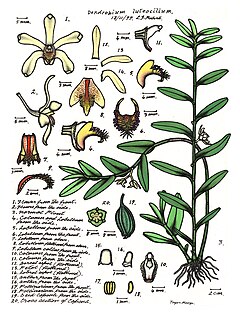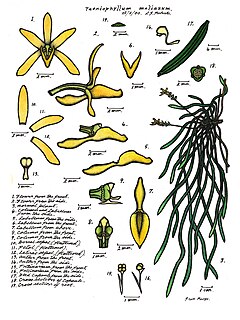
Dendrobium discolor, commonly known as antler orchids, are epiphytic or lithophytic orchids in the family Orchidaceae. They have cylindrical pseudobulbs, each with between ten and thirty five leathery leaves, and flowering stems with up to forty mostly brownish or greenish flowers with wavy and twisted sepals and petals. Antler orchids occur in northern Australia, New Guinea and Indonesia and there are several subspecies and varieties.
Bulbophyllum acropogon is a species of orchid in the genus Bulbophyllum.
Bulbophyllum rhodoglossum is a species of orchid in the genus Bulbophyllum, first described by Rudolf Schlechter in 1913 in Repertorium Specierum Novarum Regni Vegetabilis. It is an epiphyte growing in Papua New Guinea on trees in mountain forests around 1000 metres in elevation. The flowers are white, and the labellum red with a yellow tip.
Calymmanthera is a genus of flowering plants from the orchid family, Orchidaceae. It contains 5 species, native to Maluku, New Guinea, Fiji and the Solomon Islands.
- Calymmanthera filiformis(J.J.Sm.) Schltr. - New Guinea
- Calymmanthera majorSchltr. - New Guinea, Fiji and the Solomon Islands
- Calymmanthera montanaSchltr. - - New Guinea
- Calymmanthera paniculata(J.J.Sm.) Schltr. - New Guinea, Morotai
- Calymmanthera tenuisSchltr. - New Guinea
Lemurella is a genus of flowering plants from the orchid family, Orchidaceae. It contains 4 currently recognized species, native to Madagascar and to the Comoro Islands.
- Lemurella culicifera(Rchb.f.) H.Perrier
- Lemurella pallidifloraBosser
- Lemurella papillosaBosser
- Lemurella virescensH.Perrier

Monophyllorchis is a monotypic genus of flowering plants from the orchid family, Orchidaceae. The sole species is Monophyllorchis microstyloides, native to Costa Rica, Nicaragua, Colombia and Ecuador.

Dipodium stenocheilum, commonly known as tropical hyacinth-orchid, is a leafless saprophytic orchid that is endemic to northern Australia. For most of the year the plant is dormant but in summer it produces a tall flowering stem with up to twenty five white flowers with purple spots and a mauve labellum.
Goodyera yunnanensis is a species of orchid endemic to southern China. It has been reported only from the provinces of Yunnan and Sichuan, growing in forest scrub at elevations of 2,600–3,900 m (8,500–12,800 ft).
Habenaria ferdinandi, commonly known as the yellow rein orchid, is a species of orchid that is endemic to the Northern Territory. It usually has two leaves at its base and up to fifteen tiny yellowish green, strongly scented flowers.
Habenaria hymenophylla, commonly known as the coastal rein orchid, is a species of orchid that is endemic to northern Australia. It up to eight leaves scattered along the stem and up to thirty smelly green and white flowers.
Habenaria triplonema, commonly known as the twisted rein orchid, is a species of orchid that is endemic to northern Australia. It two or three leaves at its base and up to twenty five yellowish, strongly scented flowers.

Dendrobium bifalce, commonly known as the native bee orchid, is an epiphytic or lithophytic orchid in the family Orchidaceae. It has spindle-shaped pseudobulbs with up to four leathery leaves and up to ten pale green or greenish yellow flowers with purplish markings. It grows on trees and boulders in rainforest in tropical North Queensland, Australia and in New Guinea.

Dendrobium canaliculatum, commonly known as the brown tea tree orchid or thin tea tree orchid, is an epiphytic or lithophytic orchid in the family Orchidaceae. It has cone-shaped or onion-shaped pseudobulbs, up to six deeply channelled, dark green leaves and up to thirty star-shaped, light brown to caramel-coloured white or greenish to apricot-coloured flowers with darker tips. It grows in tropical North Queensland and New Guinea.
Dendrobium insigne, commonly known as the mangrove tartan orchid, is a species of epiphytic or lithophytic orchid native to New Guinea and Indonesia. It has crowded, cane-like stems with many leaves arranged in two vertical rows, and short-lived yellow and red flowers in groups of two or three.

Dendrobium pruinosum, commonly known as the honey orchid, is an epiphytic or lithophytic orchid in the family Orchidaceae and has flattened, yellowish stems and pairs of cream coloured, dull yellow or greenish flowers. It grows in tropical North Queensland and New Guinea.
Dendrobium maidenianum, commonly known as the coastal burr orchid, is an epiphytic or lithophytic orchid in the family Orchidaceae and is endemic to tropical North Queensland, Australia. It has a single thin, dark green leaf on a thin stem and one or two small white flowers that self-pollinate. It grows on trees and rocks in shady rainforest.

Schoenorchis sarcophylla, commonly known as the fleshy flea orchid, is a small epiphytic orchid with many thin roots, between three and seven crowded, dark green leaves and up to thirty crowded, tube-shaped white flowers. It is found in New Guinea and tropical North Queensland.

Taeniophyllum malianum, commonly known as the tangled ribbonroot, is a species of leafless epiphytic or lithophytic orchid that forms tangled clumps. It has flattened green roots with irregular white spots and pressed against the substrate on which it is growing. There are up to fifteen fragrant yellow, short-lived flowers with up to three open at the same time. It only occurs in tropical North Queensland and in New Guinea.
Trachoma papuanum, commonly known as the yellow spectral orchid, is an epiphytic or lithophytic clump-forming orchid with a between three and six thick, fleshy leaves and many dull yellow flowers with a white labellum opening in groups of up to four. This orchid occurs in New Guinea, Queensland and some islands in the South Pacific.
Bryobium dischorense, commonly known as the spotted urchin orchid, is an epiphytic or lithophytic clump-forming orchid that has fleshy, oval pseudobulbs, each with a single thin leaf and between four and eight cup-shaped, cream-coloured or whitish flowers with red spots. This orchid occurs in New Guinea and Queensland.







